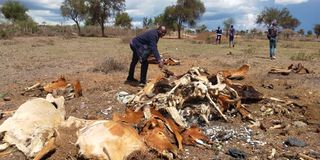Premium
Kenya: Shame of a country that cannot feed itself

Simon Kisipan points at a heap of livestock carcases at Ekinye Village in Kajiado East on December 9, 2022.
What you need to know:
- Experts have predicted frequent extreme weather events in the continent than anywhere else in the world.
- The 2022 rainy season was recorded to be the driest in over 40 years, with an estimated 43,000 in Somalia dying in 2022.
Despite accounting for less than four per cent of global greenhouse gas (GHG) emissions, Africa bears the biggest brunt from the effects of climate change.
Over the years, the continent has found itself at the epicenter of the global climate crisis, with experts predicting frequent extreme weather events in the continent than anywhere else in the world.
According to the Intergovernmental Panel on Climate Change IPCC, temperatures in Africa are projected to rise faster than the global average, ranging from increases of 0.2℃ per decade at the low end, to more than 0.5℃ per decade at the high end.
In Kenya, the State of the Climate- Kenya 2020 Report by the Kenya Meteorological Department indicated that temperature values recorded during 2020 were higher than the average temperature for the 1981 to 2012 period, and the cold season for Kenya (June to August) had the greatest deviation from normal compared to the other months of the year.
In East Africa, scientists have been sounding the alarm on the rising temperatures for years, at the same time warning on the increasing frequency of drought, and this was witnessed.
Between 2020 and 2023, the Horn of Africa experienced the worst drought in four decades, affecting Somalia, Ethiopia, and Kenya.
The 2022 rainy season was recorded to be the driest in over 40 years, with an estimated 43,000 in Somalia dying in 2022.
These changes are expected to have an impact on agriculture in the region, weakening already fragile food systems.
Some of the impacts include reduced crop and livestock productivity.
There are many reasons climate change poses such an immense challenge for African agriculture.
Up to 95 per cent of the continent’s farmers do not have irrigation systems, meaning they are entirely reliant on rainfall.
In Kenya, for instance, agriculture is largely rain fed, with 98 percent of it depending on rainfall.
Scientists project a decrease in the amount of rainfall in many parts of the continent and drought incidences becoming more frequent. Against this gloomy backdrop, farmers living in the continent’s dry regions will struggle to find enough water for their crops. According to experts, many crops that make up African diets, such as maize and wheat, will struggle to survive rising temperatures.
Under warming of 2℃, crop yields across sub-Saharan Africa will decrease by 10 per cent.
Warming beyond the 2℃ mark will cause crops yields to fall by up to 20 per cent, and in the worst case scenario where warming reaches 3℃, all present-day cropping areas for maize, millet and sorghum in Africa will become unsuitable.
This would be devastating for Africa’s food security, Kenya included, where maize is considered the main staple food.
The 2020 The United Nations Office for the Coordination of Humanitarian Affairs UNOCHA report, indicated that food security situation in the ASAL counties in Kenya was reportedly at one of the lowest levels in the last 15 years.
Depressed rainfall
A 2020 agrometeorological report indicated that maize, beans and tea grown in western Kenya were impacted by the rainfall seasons. In Central Kenya, where maize, potatoes, peas and beans are grown, there was a false onset of the March to May (MAM) rains and a depressed season.
In April there was excess rainfall leading to yields ranging from below normal to near normal. Over South-eastern and Coastal Kenya, maize and beans are the main crops grown; yields were poor due to depressed rain during the short rains season.
These challenges are compounded by rapid population growth. In Kenya, from 1960 to 2022, the population increased from 8.12 million to 54.03 million people, and aaccording to experts, feeding this growing population will be an uphill task in a region where farmers are at the mercy of increasingly severe climate impacts.
“The reason as to why climate change poses such an immense challenge for African agriculture and livelihoods is because they are heavily climate dependent. This, destabilizes food security because crop production relies on relatively predictable year to year climatic conditions,” explains Dr Sheila Ochugboju, the Executive Director for the Alliance for Science, a global communications initiative that provides science-based materials on emerging science issues among them climate change.
One way to adapt to this, according to Dr Mukani Moyo from the International Potato Center (CIP), a CGIAR center, in Kenya, is to cultivate naturally climate-resilient food crops that have been grown for centuries in Africa, but are often neglected globally by major seed companies.
“As a continent we are still suffering from colonization in that we have adapted to eating foreign foods which we don’t even produce, while neglecting our traditional crops that were adaptive to the African climatic conditions,” explains Enock Chikava, Interim Director, Agricultural Development, Bill & Melinda Gates Foundation.
And that’s why today, experts with the Accelerating Impact of CGIAR Climate Research for Africa (AICCRA) are partnering with colleagues in Kenya to support farmers in Taita-Taveta County with new high-yielding, drought-tolerant varieties of pearl millet, sorghum and pigeon pea.
But climate change also has a negative impact on livestock production. Pastoralism is one of the main economic activities for Kenyan communities within the arid and semi-arid areas, accounting for over 90 percent of rural family incomes in the dry lands of Northern Kenya.
But rising temperatures and low annual rainfall are threatening this activity, reducing livestock productivity and at the same time inhibiting the growth of fodder crops. In pastoral areas especially in the Northern part of the country, millions of livestock were lost during the prolonged drought- termed the worst to have ever been experienced in over 40 years, with the State Department of Livestock confirming that more than 2.5 million head of livestock were lost.
Livestock production plays an important role in Kenya’s food security as millions of people across the country depend on the sector for food, and so it is as significant as crop production.
With the climate induced challenges facing the whole agriculture sector, to prepare for these future challenges, experts say that the agricultural significant advancements in Africa’s food systems will be required.
According to Bernard Kimoro, Head of Climate Change and Livestock Sustainability at the State Department of Livestock Development, there is need for investment that will support climate smart agriculture.
“One of the ways is by embracing technology in food systems so as to produce improved crops that are resistant to drought and disease, to those that are tolerant to increased salt,” explains Dr Sheila Ochugboju.
But while climate change is to blame for reduction of crop yields and lowering livestock productivity, on the other hand, agriculture is a substantial driver of greenhouse gas emissions that are a major driver of climate change.
Agriculture-related emissions of carbon dioxide account for around 11 percent of global greenhouse gas emissions. Livestock production is a substantial driver of greenhouse gas emissions, estimated at 14.5 percent of total global emissions. The largest part often comes from livestock production, such as emissions released during the digestive process of ruminants, storage and application of manure, and fodder production.
According to Dr Todd Crane, Head of Delegation and Principal scientist, Climate change adaptation, International Livestock Research Institute and the CGIAR Initiative for Livestock and Climate, the main challenge in livestock and climate, both in terms of adaptation and mitigation, is feeding.
“With the increased climate stress, feeding animals can become more difficult because the fodder and pastures grow less well under hotter conditions. It also causes heat stress on the animals,” he adds
So, if we're looking for a best-bet practice that addresses climate change mitigation and adaptation most effectively, he says, feeding of animals must be improved, for them to remain productive and healthy, making them more resilient to climatic stresses.
However, he says, there needs to be caution such that improved feeding of animals doesn't come at the cost of, say, conversion of forest to hay production, especially in dairy systems.





